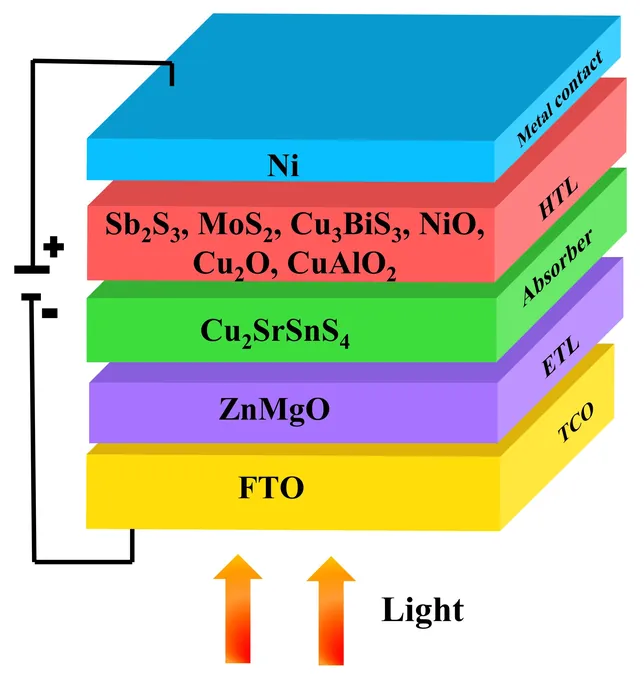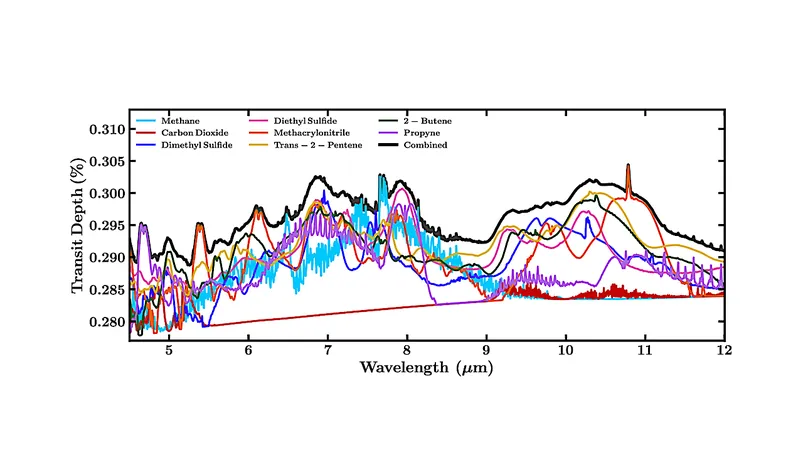
Unlocking the Future: How Improved Hole Transport Layers Could Skyrocket Cu₂SrSnS₄ Solar Cell Efficiency!
2025-05-10
Author: Arjun
In the quest for sustainable energy, thin film solar cells like CdTe and CIGSe have long dazzled scientists with their affordability and impressive power conversion efficiencies (PCE). However, issues of toxicity and the rarity of their materials are stumbling blocks to broader adoption.
Enter Cu₂SrSnS₄, a game-changing semiconductor that’s making waves due to its environmentally friendly nature and abundant availability. With a tunable bandgap and remarkable absorption properties, it holds great promise. But there's a catch: currently, its PCE sits at a modest 0.6%, signaling a need for significant advancements to rival existing technologies.
The primary hurdle? A troubling open circuit voltage (VOC) loss, primarily caused by poor alignment between the absorber and its transport layers. To tackle this, researchers are tirelessly seeking the perfect device configuration.
Using the cutting-edge SCAPS-1D simulation software, a team took on this challenge, leading to exciting developments that are poised to transform performance. Their findings, published in the Journal of Physics and Chemistry of Solids, detail a variety of device configurations that could enhance Cu₂SrSnS₄ solar cells.
They tested six innovative designs, incorporating chalcogenide and oxide-based hole transport layers (HTLs) like Sb₂S₃, MoS₂, and break-through materials like Cu₂O and NiO. Each design was meticulously analyzed alongside a ZnMgO electron transport layer (ETL) to gauge the true impact of HTLs.
The results? A significant leap in performance with the addition of HTLs, particularly from the oxide-based layers. The standout was solar cells with Cu₂O HTL, achieving an astonishing champion PCE of 18.48%. That’s not just an improvement — it’s a revolution!
But what made Cu₂O the star of the show? The researchers conducted a comprehensive comparative analysis, diving deep into energy band diagrams, electric fields, and electron distributions to unearth the reasons behind its superior performance. They discovered that Cu₂O solar cells achieved almost flawless band alignment at their interfaces, resulting in minimal barriers for electron and hole movement.
Moreover, these cells exhibited a robust electric field and impressive recombination resistance, which are pivotal for high efficiency. This performance peak is a clear indication that Cu₂SrSnS₄ solar cells, when paired with the Cu₂O HTL configuration, are on the verge of an efficiency breakthrough.
In essence, this research offers invaluable insights for the photovoltaic community, highlighting the crucial role of HTLs in boosting solar cell performance. The findings suggest that the future of Cu₂SrSnS₄ solar cells could indeed shine brighter with the adoption of this champion device structure: FTO/ZnMgO/Cu₂SrSnS₄/Cu₂O/Ni.
Stay tuned as these advancements unfold, possibly revolutionizing the solar energy market!




 Brasil (PT)
Brasil (PT)
 Canada (EN)
Canada (EN)
 Chile (ES)
Chile (ES)
 Česko (CS)
Česko (CS)
 대한민국 (KO)
대한민국 (KO)
 España (ES)
España (ES)
 France (FR)
France (FR)
 Hong Kong (EN)
Hong Kong (EN)
 Italia (IT)
Italia (IT)
 日本 (JA)
日本 (JA)
 Magyarország (HU)
Magyarország (HU)
 Norge (NO)
Norge (NO)
 Polska (PL)
Polska (PL)
 Schweiz (DE)
Schweiz (DE)
 Singapore (EN)
Singapore (EN)
 Sverige (SV)
Sverige (SV)
 Suomi (FI)
Suomi (FI)
 Türkiye (TR)
Türkiye (TR)
 الإمارات العربية المتحدة (AR)
الإمارات العربية المتحدة (AR)